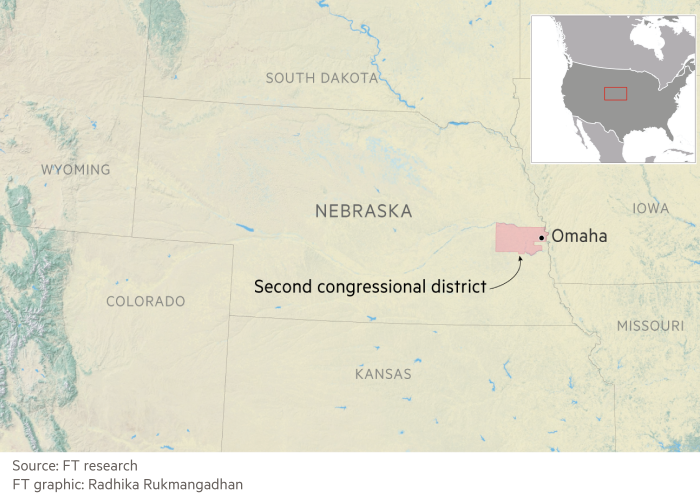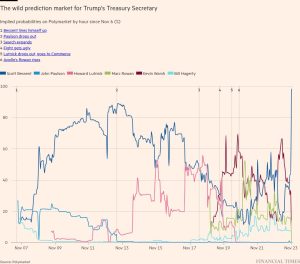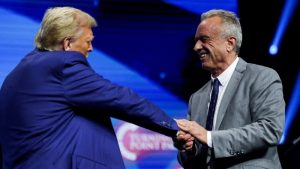why Trump, Harris and the world are watching Omaha

In some possible futures, the small Midwest city of Omaha, Nebraska, will be the world’s most important place next month: the crucial vote that hands the White House to Donald Trump or Kamala Harris.
Omaha is the largest city in a Republican state, and makes up the bulk of its second congressional district. But Nebraska, unlike nearly every other state, does not pick its delegates to the US’s unique electoral college — the body that actually elects the president — based only on the state’s overall vote.
Instead, Nebraska awards two electoral votes to its statewide winner, and one each to the winner of its three congressional districts. That Omaha district — Nebraska 2 — is also unique in the state because its vote is prone to switching.
In a knife-edge election between Harris and Trump, where the 538 delegates in the electoral college are otherwise closely split, it means Nebraska 2 could be decisive.
“Republicans are looking at all the other states and saying this isn’t fair,” said Richard Witmer, a political scientist at Omaha’s Creighton University. “Democrats retort that, if she wins the popular vote in this congressional district, why should those votes be wasted?”

With just two and a half weeks until the election on November 5, Trump and Harris are pouring money and time into their campaigns across the crucial seven swing states.
Pennsylvania, the battleground with most electoral college votes up for grabs, is getting the most attention. It would be possible to secure the election without winning Pennsylvania, but unlikely — partly because many pundits think victory there would also bring victory in the other traditionally Democratic “blue wall” swing states of Wisconsin and Michigan.
In 2016, Trump flipped these Midwestern states in his favour, allowing him to win the White House. But four years later, Joe Biden won all three of them back — paving the way for his own electoral college victory.
But in mathematical terms, there are scores of other pathways to winning the necessary votes in the electoral college, with and without Pennsylvania.
For example, either candidate could shore up support in the southern swing states, and Harris would score a big win if she could flip North Carolina — a long-standing Democratic target that Trump won by a razor-thin margin in 2016 — and its 16 electoral college votes back to the Democrats’ column.
Here is one way to enumerate the routes: there are 128 combinations of possible outcomes in the seven swing states (two candidates to the seventh power) where polls suggest the races are effectively tied.
In four of the combinations, the result would hinge on a single electoral vote. One of those combinations in particular is utterly plausible, and the Harris campaign is doggedly pursuing it.
If Harris wins the three blue wall states and Trump carries the sunbelt (Arizona, Georgia, Nevada and North Carolina), Nebraska 2 will be pivotal. If Harris wins it, she wins the presidency. If Trump wins it, the election is tied.
Trump would very likely prevail from an electoral college tie, which would be resolved by the House of Representatives. In a constitutional quirk, each state would get just one vote and Republicans currently have a majority of states represented in the chamber. (In an additional quirk, the Senate would choose the vice-president separately.) An electoral college tie has only happened twice before in history.
While the campaigns are rushing across the big swing states, they also see the potential power of Nebraska 2.
Harris’s running mate, Minnesota governor Tim Walz, plans to campaign in the district this weekend, and Democrats have spent $12mn on ads in Nebraska. The Trump campaign has spent almost nothing on ads but has aggressively lobbied the state’s legislature to change its rules, become winner-take-all and essentially gift one electoral vote to Trump. Those efforts were stymied by a single Republican state senator. He has been hailed as a hero by Democrats. On social media, Trump derided him as “Just another ‘Grandstander!’”
“It’s about not making us a flyover state any more,” the senator, Republican Mike McDonnell, told the Financial Times on Thursday. Nebraska’s rare system was about “us being relevant, the economic impact and the idea of [presidential candidates] working for our vote”, he said.
McDonnell was also motivated by the local ethos of “Nebraska nice”. “That sounds like a weakness — it’s not,” he said. “We work hard and we play by the rules.” He compared a would-be change in the system to introducing new football rules with two minutes left in a game. “Can you imagine that stadium? People would go crazy.”
The few polling surveys of Nebraska 2 that exist show Harris with a 6-point lead, according to Financial Times averages. But the lead comes with much uncertainty.
In Omaha, meanwhile, the locals are now duelling with yard signs tailored to their unique electoral position. Harris supporters display single blue dots, symbolising a Democratic holdout in a Republican state. Trump supporters display all-red maps — in the shape of Nebraska.
McDonnell believes that the entire country should adopt Nebraska’s system and that it would be “more democratic”. If Nebraska were winner-take-all, like most of the country, there would be no blue dots or red maps, no candidate visits or local political spending, and far less local debate.
“It does something for American democracy, to think your vote matters,” Witmer said.
Additional reporting by Sam Learner
#Trump #Harris #world #watching #Omaha







